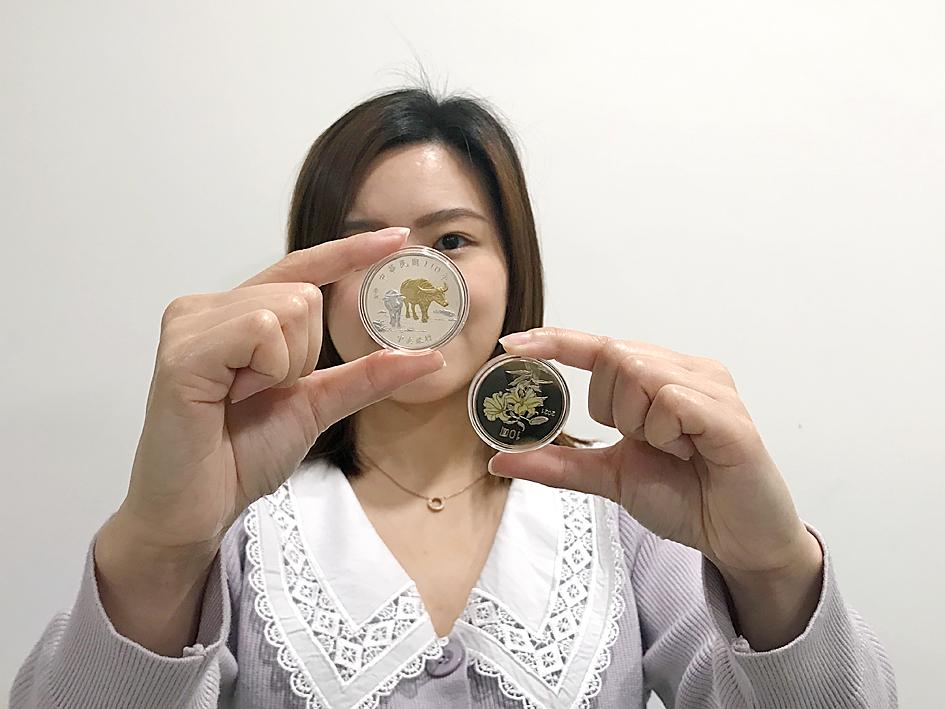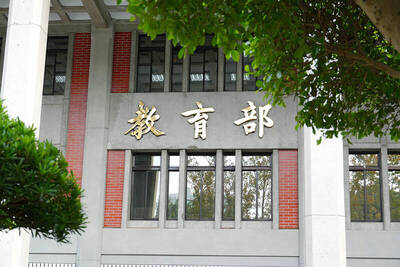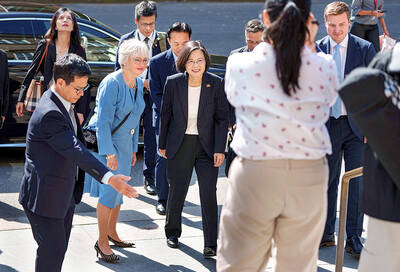A set of Chinese zodiac commemorative coins for the Year of the Ox was released for sale in brick-and-mortar banks on Jan. 21, after being available for online preorder since Jan. 7 — the first time in the central bank’s history to accept preorders of its annual commemorative coins.
However, the Year of the Ox coins are unlikely to recapture the glory days of zodiac sign coinage when huge crowds lined up in front of bank branches on the coins’ release date, central bank officials said.
This was due to a shrinking aftermarket for collectible coins, but also due to a declining birthrate, they said.

Photo: Chen Mei-ying, Taipei Times
Although coin collectors take for granted that the central bank would every Lunar New Year release a set of commemorative coins, the annual release might not be carried on forever, they said.
The central bank minted its first zodiac sign coins to commemorate the Year of the Rooster in 1993 “essentially as an experiment,” Issuance Department Director-General Shih Tsuen-hua (施遵驊) said.
The central bank was tightfisted at the time, and what became an annual tradition might well have been discontinued if the rooster coins did not find so many fans among collectors, Shih said.
From 1993 to 2004, the central bank issued square zodiac sign coins, which made them rare and much sought-after. They came in editions between 50,000 and 180,000 coins, and in several denominations.
In 2005, the central bank ushered in what it called “round-two” commemorative coins, minting round coins with increased silver content, denominations of NT$20 to NT$50 and a editions of 120,000 per year.
That issuance volume remained the same for more than a decade, with the exception of 2012, when the central bank expected heightened demand for the Year of the Dragon coins and issued 150,000 sets.
The Year of the Dragon coins were sold out in less than two hours, proving the central bank’s instincts right.
Several numismatic clubs paid people to wait in the exceptionally long lines on their behalf, and black-clad men believed to be gangsters were also seen lining up for a set of coins.
Those who secured a set saw the value of their coins increase by NT$1,500 on the spot.
A craze for the Taiwanese dragon coins was also reported in China.
However, that year marked the high point for the zodiac sign coins, and after the central bank in 2017 initiated “round three” of commemorative coins, sales began to decline.
That year was the last time that the coins sold out on the day of their release.
In response to the trend, the central bank last year began reducing the coins’ edition, and this year only minted 100,000 Year of the Ox coins.
So far, online preorders have shown a lack of interest among the public, justifying the bank’s pessimism.
“The COVID-19 pandemic probably has something to do with it, although making the coin available online probably diverted some of the remaining buyers,” Shih said. “The younger generation is not really interested in collecting coins.”
Taiwan’s aging population is one of the main reasons for the nation’s fading interest in zodiac sign coins, a collector surnamed Wang (王) said.
“People bought zodiac sign coins for their own collection or as gifts to family and friends, and especially for those who recently had children. A coin from the birth year of a child was a much sought-after possession,” Wang said. “However, birthrates are falling, and young people do not collect coins.”
Taipei Stamp and Coin Trade Association director-general Hsu Chiu-chi (許求麒) said that coin collecting has gone out of fashion over the past five years, adding that buying coins is “a losing investment.”
“The highest-value coins are probably the 1993 Year of the Rooster coins because they were the first. However, nobody is selling those, and there is virtually no market for them,” he said.
The other round-one coins have denominations from NT$300 to NT$500, and selling prices are about NT$100 higher than their face value, he said.
Former Taipei Numismatics Society secretary-general Chou Chien-fu (周建福) said that the central bank is in part to blame for the situation in the coin market.
Unlike monetary officials in other countries, the central bank deems the zodiac sign coins currency and limits their issuance in line with its monetary policy, Chou said.
“The central bank uses monetary policy as an instrument to rein in speculation, but this kills the aftermarket trade of the coins,” he said.
Thus, Taiwan’s numismatic societies have declined from a peak of more than 100 groups to just 30, Chou added.
“Commemorative coins are either currency or merchandise. The regulatory policies for these categories are fundamentally different,” he said.

The Ministry of Education (MOE) is to launch a new program to encourage international students to stay in Taiwan and explore job opportunities here after graduation, Deputy Minister of Education Yeh Ping-cheng (葉丙成) said on Friday. The government would provide full scholarships for international students to further their studies for two years in Taiwan, so those who want to pursue a master’s degree can consider applying for the program, he said. The fields included are science, technology, engineering, mathematics, semiconductors and finance, Yeh added. The program, called “Intense 2+2,” would also assist international students who completed the two years of further studies in

Former president Tsai Ing-wen (蔡英文) departed for Europe on Friday night, with planned stops in Lithuania and Denmark. Tsai arrived at Taiwan Taoyuan International Airport on Friday night, but did not speak to reporters before departing. Tsai wrote on social media later that the purpose of the trip was to reaffirm the commitment of Taiwanese to working with democratic allies to promote regional security and stability, upholding freedom and democracy, and defending their homeland. She also expressed hope that through joint efforts, Taiwan and Europe would continue to be partners building up economic resilience on the global stage. The former president was to first

Former president Tsai Ing-wen (蔡英文) on Monday called for greater cooperation between Taiwan, Lithuania and the EU to counter threats to information security, including attacks on undersea cables and other critical infrastructure. In a speech at Vilnius University in the Lithuanian capital, Tsai highlighted recent incidents in which vital undersea cables — essential for cross-border data transmission — were severed in the Taiwan Strait and the Baltic Sea over the past year. Taiwanese authorities suspect Chinese sabotage in the incidents near Taiwan’s waters, while EU leaders have said Russia is the likely culprit behind similar breaches in the Baltic. “Taiwan and our European

The Taipei District Court sentenced babysitters Liu Tsai-hsuan (劉彩萱) and Liu Jou-lin (劉若琳) to life and 18 years in prison respectively today for causing the death of a one-year-old boy in December 2023. The Taipei District Prosecutors’ Office said that Liu Tsai-hsuan was entrusted with the care of a one-year-old boy, nicknamed Kai Kai (剴剴), in August 2023 by the Child Welfare League Foundation. From Sept. 1 to Dec. 23 that year, she and her sister Liu Jou-lin allegedly committed acts of abuse against the boy, who was rushed to the hospital with severe injuries on Dec. 24, 2023, but did not